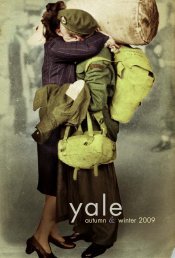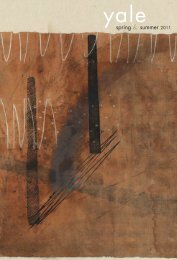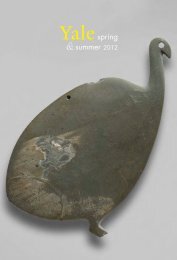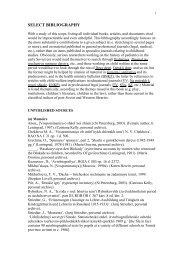View & Download - Yale University Press
View & Download - Yale University Press
View & Download - Yale University Press
You also want an ePaper? Increase the reach of your titles
YUMPU automatically turns print PDFs into web optimized ePapers that Google loves.
Annette Carruthers is a senior<br />
lecturer in the School of Art History<br />
at the <strong>University</strong> of St Andrews.<br />
October 468 pp. 285x245mm.<br />
100 colour + 250 b/w illus.<br />
HB ISBN 978-0-300-19576-7 £60.00*<br />
The Arts and Crafts Movement<br />
in Scotland<br />
Art 49<br />
A History<br />
Annette Carruthers<br />
This authoritative book is the first to chronicle the Arts and Crafts<br />
movement in Scotland. Arts and Crafts ideas appeared there from the<br />
1860s, but not until after 1890 did they emerge from artistic circles<br />
and rise to popularity among the wider public. The heyday of the<br />
movement occurred between 1890 and 1914, a time when Scotland’s<br />
art schools energetically promoted new design and the Scottish Home<br />
Industries Association campaigned to revive rural crafts. Across the<br />
country the movement influenced the look of domestic and church<br />
buildings, as well as the stained glass, metalwork, textiles and other<br />
furnishings that adorned them. Art schools, workshops and associations<br />
helped shape the Arts and Crafts style, as did individuals such as Ann<br />
Macbeth, W. R. Lethaby, Robert Lorimer, M. H. Baillie Scott, Douglas<br />
Strachan, Phoebe Traquair and James Cromar Watt, among other wellknown<br />
and previously overlooked figures. Together, these architects,<br />
artists, and designers contributed to the expansion and evolution of the<br />
movement both within and beyond Scotland’s borders.<br />
Published for the Paul Mellon Centre for Studies in British Art<br />
From Still Life<br />
to the Screen<br />
Print Culture, Display, and<br />
the Materiality of the Image<br />
in Eighteenth-Century<br />
London<br />
Joseph Monteyne<br />
From Still Life to the Screen<br />
explores the print culture of<br />
18th-century London, focusing<br />
on the correspondences between images and consumer objects.<br />
In his lively and insightful text, Joseph Monteyne considers<br />
such themes as the display of objects in still lifes and markets,<br />
the connoisseur’s fetishistic gaze, and the fusion of body and<br />
ornament in satires of fashion. The desire for goods emerged<br />
in tandem with modern notions of identity, in which things<br />
were seen to mirror and symbolise the self. Prints, particularly<br />
graphic satires by such artists as Matthew and Mary Darly,<br />
James Gillray, William Hogarth, Thomas Rowlandson and<br />
Paul Sandby, were actively involved in this shift. Many of these<br />
images play with the boundaries between the animate and the<br />
inanimate, self and thing. They also reveal the recurring motif<br />
of image display, whether on screens, by magic lanterns, or in<br />
‘raree-shows’ and print-shop windows. The author links this<br />
motif to new conceptions of the self, specifically through the<br />
penetration of spectacle into everyday experience.<br />
Joseph Monteyne is associate professor in the history of art at<br />
the <strong>University</strong> of British Columbia.<br />
Published for the Paul Mellon Centre for Studies in British Art<br />
August 288 pp. 256x192mm. 55 colour + 101 b/w illus.<br />
HB ISBN 978-0-300-19635-1 £35.00*<br />
Exhibiting Englishness<br />
John Boydell’s Shakespeare<br />
Gallery and the Formation<br />
of a National Aesthetic<br />
Rosie Dias<br />
In the late 18th century, as a<br />
wave of English nationalism<br />
swept the country, the printseller<br />
John Boydell set out to create an<br />
ambitious exhibition space, one<br />
devoted to promoting and<br />
fostering a distinctly English style of history painting. With its<br />
very name, the Shakespeare Gallery signalled to Londoners<br />
that the artworks on display shared an undisputed quality and<br />
a national spirit. Exhibiting Englishness explores the responses<br />
of key artists of the period to Boydell’s venture and sheds new<br />
light on the gallery’s role in the larger context of British art.<br />
Tracking the shift away from academic and Continental<br />
European styles of history painting, the book analyses the<br />
works of such artists as Joshua Reynolds, Henry Fuseli, James<br />
Northcote, Robert Smirke, Thomas Banks and William<br />
Hamilton, laying out their diverse ways of expressing notions<br />
of individualism, humour, eccentricity and naturalism.<br />
Exhibiting Englishness also argues that Boydell’s gallery<br />
radically redefined the dynamics of display and cultural<br />
aesthetics at that time, shaping both an English school of<br />
painting and modern exhibition practices.<br />
Rosie Dias is associate professor in the history of art at the<br />
<strong>University</strong> of Warwick.<br />
Published for the Paul Mellon Centre for Studies in British Art<br />
August 288 pp. 256x192mm. 50 colour + 95 b/w illus.<br />
HB ISBN 978-0-300-19668-9 £45.00*












